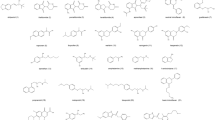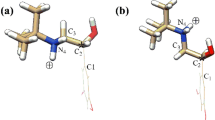Abstract
β-Lactams are one of the most widely used types of antibiotics. As β-lactams are chiral, the enantiomeric separation of these compounds was investigated using cyclodextrins, frequently used as chiral separators. Molecular modeling methods were utilized in order to predict possible enantioseparation of four model compounds. Our results revealed that permethylated β-cyclodextrin is more likely to chirally separate the phenylazetidin derivates than the parent β-cyclodextrin. LC experiments using cyclodextrin as chiral stationary phase in most cases confirmed our prediction; however, more experiments and statistical evaluation of the results are needed in order to judge the prediction power of the molecular dynamic method.







Similar content being viewed by others
References
Maier NM, Franco P, Lindner W (2001) J Chromatogr A 906:3–33. doi:10.1016/S0021-9673(00)00532-X
Zhang Y, Wu DR, Wang-Iverson DB, Tymiak AA (2005) Drug Discov Today 10:571–577. doi:10.1016/S1359-6446(05)03407-0
Juvancz Z, Kendrovics RB, Ivanyi R, Szente L (2008) Electrophoresis 29:1701–1712. doi:10.1002/elps.200700657
Juvancz Z, Szejtli J (2002) Trac-Trends in Anal Chem 21:379–388
Scriba GK (2008) J Sep Sci 31:1991–2011. doi:10.1002/jssc.200800095
Schneiderman E, Stalcup AM (2000) J Chromatogr B Biomed Sci Appl 745:83–102. doi:10.1016/S0378-4347(00)00057-8
Berthod A (2006) Anal Chem 78:2093–2099. doi:10.1021/ac0693823
Ali I, Kumerer K, Aboul-Enein HY (2006) Chromatographia 63:295–307. doi:10.1365/s10337-006-0762-5
Cramer F, Dietsche W (1959) Chem Ber 92:378–384
Kano K (1997) J Phys Org Chem 10:286–291
Leffingwell JC (2003) Leffingwell Reports 3:1–27
Yanagida A, Shoji A, Shibusawa Y, Shindo H, Tagashira M, Ikeda M, Ito Y (2006) J Chromatogr A 1112:195–201. doi:10.1016/j.chroma.2005.09.086
Kodama S, Yamamoto A, Matsunaga A, Yanai H (2004) Electrophoresis 25:2892–2898. doi:10.1002/elps.200305902
Chankvetadze B (2004) Chem Soc Rev 33:337–347. doi:10.1002/chin.200442280
Hutt LD, Glavin DP, Bada JL, Mathies RA (1999) Anal Chem 71:4000–4006. doi:10.1021/ac9903959
Bikadi Z, Kurdi R, Balogh S, Szeman J, Hazai E (2006) Chem Biodivers 3:1266–1278. doi:10.1002/cbdv.200690129
Smith VK, Ndou TT, Warner IM (1994) J Phys Chem 98:8627–8631. doi:10.1021/j100086a007
Liu L, Li XS, Song KS, Guo QX (2000) J Mol Struct Theochem 531:127–134. doi:10.1016/S0166-1280(00)00440-1
Liu L, Guo QX (2004) J Inclusion Phenom Macrocycl Chem 50:95–103. doi:10.1007/s10847-003-8847-3
Yan CL, Li XH, Xiu ZL, Hao C (2006) J Mol Struct Theochem 764:95–100. doi:10.1016/j.theochem.2006.02.008
Steiner T, Saenger W (1992) J Am Chem Soc 114:10146–10154. doi:10.1021/ja00052a009
Del Rio A (2009) J Sep Sci 32:1566–1584. doi:10.1002/jssc.200800693
Lipkowitz KB, Stoehr CM (1996) Chirality 8:341–350. doi:10.1002/(SICI)1520-636X(1996)8:4<341:AID-CHIR8>3.0.CO;2-I
Dodziuk H, Ejchart A, Lukin O, Vysotsky MO (1999) J Org Chem 64:1503–1507. doi:10.1021/jo981937+
Kim H, Jeong K, Lee S, Jung SH (2003) Bull Korean Chem Soc 24:95–98
Sun M, Liu XH, Yan LS, Luo G, Zhao YF (2003) J Mol Model 9:419–422. doi:10.1007/s00894-003-0162-9
Kahle C, Deubner R, Schollmayer C, Scheiber J, Baumann K, Holzgrabe U (2005) Eur J Org Chem:1578–1589. doi:10.1002/ejoc.200400673
Waibel B, Scheiber J, Meier C, Hammitzsch M, Baumann K, Scriba GKE, Holzgrabe U (2007) Eur J Org Chem:2921–2930 doi:10.1002/ejoc.200700052
Bednarek E, Bocian W, Michalska K (2008) J Chromatogr A 1193:164–171. doi:10.1016/j.chroma.2008.04.008
Chankvetadze B, Burjanadze N, Breitkreutz J, Bergander K, Bergenthal D, Kataeva O, Frohlich R, Luftmann H, Blaschke G (2002) J Sep Sci 25:1155–1166. doi:10.1002/1615-9314(20021101)25:15/17<1155:AID-JSSC1155>3.0.CO;2-M
Bikadi Z, Ivanyi R, Szente L, Ilisz I, Hazai E (2007) Curr Drug Discov Technol 4:282–294. doi:10.2174/157016307783220549
Zhao CF, Diemert S, Cann NM (2009) J Chromatogr A 1216:5968–5978. doi:10.1016/j.chroma.2009.06.041
Kondo S, Ohtaki A, Tonozuka T, Sakano Y, Kamitori S (2001) J Biochem 129:423–428
Goodsell DS, Morris GM, Olson AJ (1996) J Mol Recognit 9:1–5. doi:10.1002/(SICI)1099-1352(199601)9:1<1:AID-JMR241>3.0.CO;2-6
Solis FJ, Wets RJB (1981) Math Oper Res 6:19–30. doi:10.1287/moor.6.1.19
Van der Spoel D, Lindahl E, Hess B, Groenhof G, Mark AE, Berendsen HJC (2005) J Comput Chem 26:1701–1718. doi:10.1002/jcc.20291
Schuttelkopf AW, van Aalten DMF (2004) Acta Crystallogr Sect D Biol Crystallogr 60:1355–1363. doi:10.1107/S0907444904011679
Morris GM, Goodsell DS, Halliday RS, Huey R, Hart WE, Belew RK, Olson AJ (1998) J Comput Chem 19:1639–1662. doi:10.1002/(SICI)1096-987X(19981115)19:14<1639:AID-JCC10>3.0.CO;2-B
Sun P, Wang C, Armstrong DW, Peter A, Forro E (2006) J Liq Chromatogr Relat Technol 29:1847–1860. doi:10.1002/chir.20714
Pirkle WH, Tsipouras A, Hyun MH, Hart DJ, Lee CS (1986) J Chromatogr 358:377–384. doi:10.1021/cr00092a006
Acknowledgment
The financial supports of Jedlik Ányos grant 00180/2007, NKFP_07_A3_NATURSEP and OTKA K 67563 are acknowledged.
Author information
Authors and Affiliations
Corresponding author
Rights and permissions
About this article
Cite this article
Bikádi, Z., Fodor, G., Hazai, I. et al. Molecular Modeling of Enantioseparation of Phenylazetidin Derivatives by Cyclodextrins. Chroma 71 (Suppl 1), 21–28 (2010). https://doi.org/10.1365/s10337-009-1461-9
Received:
Revised:
Accepted:
Published:
Issue Date:
DOI: https://doi.org/10.1365/s10337-009-1461-9




